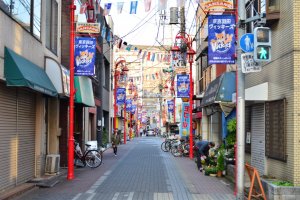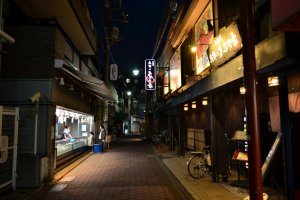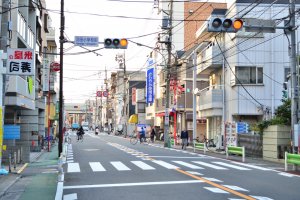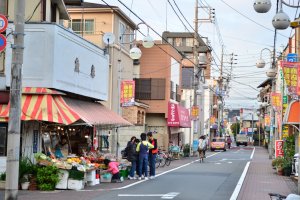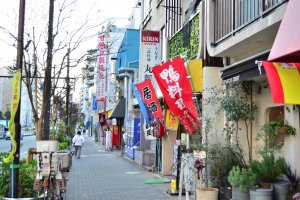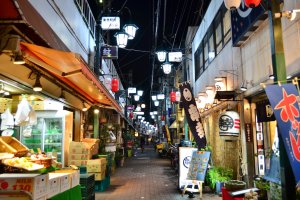Ota City is located in the south east of Tokyo and is the largest and most expansive of its wards. Many know Ota as the home of Haneda Airport, but as an area packed full of quirky streets and quaint shops, it’s easy to forget you are in one of the world’s most populous capitals once you step off the train here.
About Japanese Shotengai
Shotengai are a uniquely Japanese style of commercial district where small groups of independent retailers offering daily necessities and services populate linear shopping streets that typically start or terminate at a train station. Initially born out of medieval markets, some of the oldest shotengai date back to the late sixteenth century.
Run by local organizations, they have historically played a key role in developing neighborhood communities. These days they often support the welfare of young and elderly residents as well as organizing local events and festivities.
Modern shotengai continue to center on family-run businesses, though chain stores such as pachinko parlors and fast-food joints are starting to encroach. Many people head to shotengai to enjoy a nostalgic experience, hunt down local specialties, or sniff out bargains.
Area Guide: Kamata
Kamata is the busiest area in downtown Ota and known for its traditional Japanese lunch spots, its drinking establishments and its numerous public baths. With five shotengai on the west side and an impressive seven on the east side, it boasts around 7,500 shops in total.
Kamata West Side Shotengai:
- Kamata Nishi-guchi Cross Dori Shotenkai As the name suggests, this shopping district jam-packed with eateries and retro “snack” bars run by attentive owners is centered on two streets laid out in a cross formation.
![Kamata Nishi-guchi Cross Dori Shotenkai]()
Kamata Nishi-guchi Cross Dori Shotenkai (Photo: Ota Shotengai) - Kamata Nishi-guchi Suzuran Dori Shotengai Shinko Kumiai Here you can admire the bloom of seasonal flowers as well as colorful artwork decorating shop shutters, some of which is inspired by the popular manga “750 Rider”.
![Kamata Nishi-guchi Suzuran Dori Shotengai Shinko Kumiai]()
Kamata Nishi-guchi Suzuran Dori Shotengai Shinko Kumiai (Photo: Ota Shotengai) - Kamata Nishi-guchi Shineikai A charming narrow street thronging with one-of-a-kind restaurants that you can duck in and out of to try a variety of delicious dishes.
![Kamata Nishi-guchi Shineikai]()
Kamata Nishi-guchi Shineikai (Photo: Ota Shotengai) - Kamata Tokyu Eki-mae Dori Kai (Bourbon Road) Ideal for an evening out, this road is teeming with lively Japanese-style pubs, bars, and “snack” bars, which are typically fitted out with karaoke machines.
!['Bourbon Road', Kamata Tokyu Eki-mae Dori Kai]()
'Bourbon Road', Kamata Tokyu Eki-mae Dori Kai (Photo: Ota Shotengai) - Kamata Nishi Guchi Shotengai Shinko Kumiai (Sun Road Sunrise) This extensive covered shopping arcade is the perfect place to enjoy pottering about on a rainy day and indulge in some classic Japanese cuisine.
!['Sun Road Sunrise', Kamata Nishi Guchi Shotengai Shinko Kumiai]()
'Sun Road Sunrise', Kamata Nishi Guchi Shotengai Shinko Kumiai (Photo: Ota Shotengai)
Kamata East Side Shotengai:
- Miyanohashi Dori Shotenkai Located near Nomikawa River, this shotengai is easy to spot thanks to its iconic signage - just look up to see the red and white “ゆ (yu)” board advertising the local public bath.
![Miyanohashi Dori Shotenkai]()
Miyanohashi Dori Shotenkai (Photo: Ota Shotengai) - Onaribashi Dori Shotenkai The small shops and public baths nestled among houses and apartments on this road give the impression that they’ve always been there.
![Onaribashi Dori Shotenkai]()
Onaribashi Dori Shotenkai (Photo: Ota Shotengai) - Ayame Shotenkai This shopping street stretches all the way from Ayame Bridge intersection on either side of Ayame Dori to the Keikyu Railway train tracks.
![Ayame Shotenkai]()
Ayame Shotenkai (Photo: Ota Shotengai) - Keihin Kamata Shotengai Kyodo Kumiai (Asuto) Various entertaining events are hosted along this shotengai, and the fact that it’s roofed means they proceed as scheduled rain or shine.
!['Asuto', Keihin Kamata Shotengai Kyodo Kumiai]()
'Asuto', Keihin Kamata Shotengai Kyodo Kumiai (Photo: Ota Shotengai) - Keihin Kamata Eki-mae Dori Shotenkai As soon as you cross the main road in front of Keikyu Kamata Station, you’ll find yourself on this street full of ever popular local stores.
![Keihin Kamata Eki-mae Dori Shotenkai]()
Keihin Kamata Eki-mae Dori Shotenkai (Photo: Ota Shotengai) - Demura Dori Kyoei-kai This old-fashioned shopping street with a nostalgic feel is is said to be named after Demura train station.
![Demura Dori Kyoei-kai]()
Demura Dori Kyoei-kai (Photo: Ota Shotengai) - Kamata Higashi Guchi Shotenkai Shogyo Kyodo Kumiai (Popurado) With more than 240 shops in the area - and many of these being restaurants - you are sure to find something to tantalize your taste buds.
!['Popurado', Kamata Higashi Guchi Shotenkai Shogyo Kyodo Kumiai]()
'Popurado', Kamata Higashi Guchi Shotenkai Shogyo Kyodo Kumiai (Photo: Ota Shotengai)
Things to Do
Take some time out and relax ‘Kamata style.’ After wandering about and making your purchases try heading to one of the many public baths on offer. Here you can allow yourself a moment to unwind before stepping out for drinks at some of the offbeat bars that give this area its character.
Pickup items
Delicious nori (seaweed) crammed with minerals was cultivated here in Ota from the Edo Period (1608-1868) up until the mid 1950s. Why not taste this timeless delicacy for yourself? Alternatively, those who fancy something a bit meatier may like to indulge in some succulent karaage - fried chicken Japan style!
Area Guide: Haneda
Haneda is Tokyo’s international gateway and a place where you can explore some top aspects of the city’s Edo heritage, primarily through its food culture. The area is brimming with unique establishments serving up mouthwatering tempura and sushi dishes prepared according to traditional recipes and much more.
Haneda Shotengai:
- Nishi Kojiya Kannon-do Shotenkai An attractive shopping arcade situated midway between Kojiya Station and Otorii Station, it has a homely feel that is emphasized by the variety of fun events hosted there.
![Nishi Kojiya Kannon-do Shotenkai]()
Nishi Kojiya Kannon-do Shotenkai (Photo: Ota Shotengai) - Haneda Shotengai Shinko Kumiai This vibrant commercial center located closest to Haneda Airport is famous for hosting the biggest Shinto portable shrine parade in Ota City.
![Haneda Shotengai]()
Haneda Shotengai (Photo: Ota Shotengai) - Anamori Fureai Dori Sansan-kai After exiting Anamori-inari Station and passing through the vermillion torii gates you’ll hit this shopping street, which is identifiable by its color-matched street lamps.
![Anamori Fureai Dori Sansan-kai]()
Anamori Fureai Dori Sansan-kai (Photo: Ota Shotengai) - Otorii Shotenkai Opening out along Otorii Station intersection, this cross-shaped shopping area with a friendly local vibe offers eating and drinking establishments in addition to public baths.
![Otorii Shotengai]()
Otorii Shotengai (Photo: Ota Shotengai)
Things to Do
This area crowded with inviting shops and cozy restaurants, as well as historic shrines, is easily accessible from Haneda Airport making it the perfect place to visit during transit. It’s ideal for foodies passionate about home-cooked local flavors, whether it’s handmade soba noodles you’re after or the freshest raw sashimi.
Pickup Items
This is an area where those with a sweet tooth can get delight in beautiful traditional Japanese confectionary; the yummy adzuki bean fillings are sure to have you hooked. If savory is more your style, the deep fried tempura here is a must try. You could even pick up some hand-baked sembei rice crackers as lightweight and highly delectable souvenirs.
Access
The four Haneda shotengai are located a few stations away from Haneda Airport - between Anamori-inari, Otorii and Kojiya stations - and are accessible in minutes by train.
Meanwhile those in east and west Kamata are centered around Keikyu Kamata and Kamata stations, situated around one kilometer northwest of Kojiya. The map below outlines the two regions and the position of each shotengai:


















